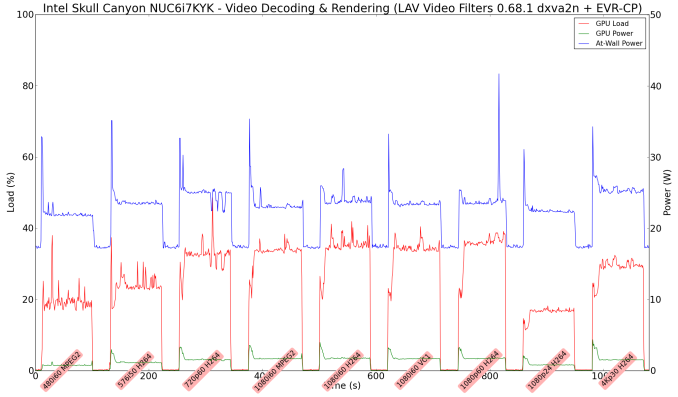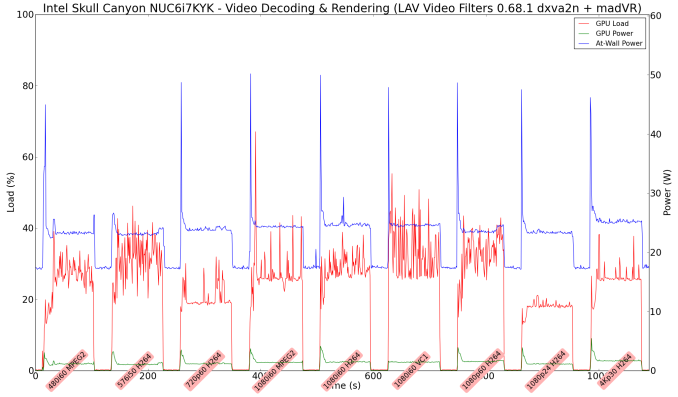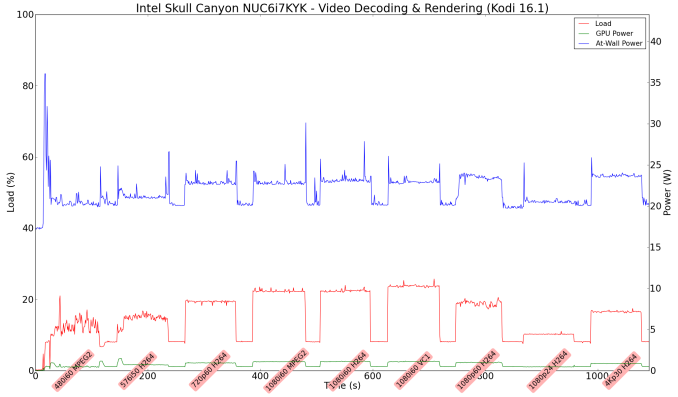The Intel Skull Canyon NUC6i7KYK mini-PC Review
by Ganesh T S on May 23, 2016 8:00 AM ESTHTPC Credentials
The higher TDP of the processor in Skull Canyon, combined with the new chassis design, makes the unit end up with a bit more noise compared to the traditional NUCs. It would be tempting to say that the extra EUs in the Iris Pro Graphics 580, combined with the eDRAM, would make GPU-intensive renderers such as madVR operate more effectively. That could be a bit true in part (though, madVR now has a DXVA2 option for certain scaling operations), but, the GPU still doesn't have full HEVC 10b decoding, or stable drivers for HEVC decoding on WIndows 10. In any case, it is still worthwhile to evaluate basic HTPC capabilities of the Skull Canyon NUC6i7KYK.
Refresh Rate Accurancy
Starting with Haswell, Intel, AMD and NVIDIA have been on par with respect to display refresh rate accuracy. The most important refresh rate for videophiles is obviously 23.976 Hz (the 23 Hz setting). As expected, the Intel NUC6i7KYK (Skull Canyon) has no trouble with refreshing the display appropriately in this setting.
The gallery below presents some of the other refresh rates that we tested out. The first statistic in madVR's OSD indicates the display refresh rate.
Network Streaming Efficiency
Evaluation of OTT playback efficiency was done by playing back our standard YouTube test stream and five minutes from our standard Netflix test title. Using HTML5, the YouTube stream plays back a 1080p H.264 encoding. Since YouTube now defaults to HTML5 for video playback, we have stopped evaluating Adobe Flash acceleration. Note that only NVIDIA exposes GPU and VPU loads separately. Both Intel and AMD bundle the decoder load along with the GPU load. The following two graphs show the power consumption at the wall for playback of the HTML5 stream in Mozilla Firefox (v 46.0.1).

GPU load was around 13.71% for the YouTube HTML5 stream and 0.02% for the steady state 6 Mbps Netflix streaming case. The power consumption of the GPU block was reported to be 0.71W for the YouTube HTML5 stream and 0.13W for Netflix.
Netflix streaming evaluation was done using the Windows 10 Netflix app. Manual stream selection is available (Ctrl-Alt-Shift-S) and debug information / statistics can also be viewed (Ctrl-Alt-Shift-D). Statistics collected for the YouTube streaming experiment were also collected here.

Decoding and Rendering Benchmarks
In order to evaluate local file playback, we concentrate on EVR-CP, madVR and Kodi. We already know that EVR works quite well even with the Intel IGP for our test streams. Under madVR, we used the DXVA2 scaling logic (as Intel's fixed-function scaling logic triggered via DXVA2 APIs is known to be quite effective). We used MPC-HC 1.7.10 x86 with LAV Filters 0.68.1 set as preferred in the options. In the second part, we used madVR 0.90.19.
In our earlier reviews, we focused on presenting the GPU loading and power consumption at the wall in a table (with problematic streams in bold). Starting with the Broadwell NUC review, we decided to represent the GPU load and power consumption in a graph with dual Y-axes. Nine different test streams of 90 seconds each were played back with a gap of 30 seconds between each of them. The characteristics of each stream are annotated at the bottom of the graph. Note that the GPU usage is graphed in red and needs to be considered against the left axis, while the at-wall power consumption is graphed in green and needs to be considered against the right axis.
Frame drops are evident whenever the GPU load consistently stays above the 85 - 90% mark. We did not hit that case with any of our test streams. Note that we have not moved to 4K officially for our HTPC evaluation. We did check out that HEVC 8b decoding works well (even 4Kp60 had no issues), but HEVC 10b hybrid decoding was a bit of a mess - some clips worked OK with heavy CPU usage, while other clips tended to result in a black screen (those clips didn't have any issues with playback using a GTX 1080).
Moving on to the codec support, the Intel Iris Pro Graphics 580 is a known quantity with respect to the scope of supported hardware accelerated codecs. DXVA Checker serves as a confirmation for the features available in driver version 15.40.23.4444.
It must be remembered that the HEVC_VLD_Main10 DXVA profile noted above utilizes hybrid decoding with both CPU and GPU resources getting taxed.
On a generic note, while playing back 4K videos on a 1080p display, I noted that madVR with DXVA2 scaling was more power-efficient compared to using the EVR-CP renderer that MPC-HC uses by default.




















133 Comments
View All Comments
ragenalien - Monday, May 23, 2016 - link
Could we get a comparison between this and the iris pro 6200? Seems like there isn't much difference performance wise, but there should be.defaultluser - Monday, May 23, 2016 - link
Skylake gets much better GPU performance/watt than Broadwell did, as evidenced by the NUC with 48 EU 64MB eDRAM being fed by just 23w continuous. That's a huge improvement form the 45w this beast used to take!I think the only surprise for me was just 40% performance improvement over the 4770r. I always assumed the 4770r was bandwidth-limited, but I guess the eDRAM cache was enough to keep things fed.
But yeah, pointless product continues to be pointless. Intel charges a premium for these things because they take up more die space and require dedicated eDRAM cache to feed them...just like discrete GPUs take up more die space, and require dedicated DRAM to feed them. Where is the efficiency gain in this crap?
defaultluser - Monday, May 23, 2016 - link
Oh, I just noticed the review uses 2133 DDR4, which would account for the 40% performance increase we saw. I thought for sure a "premium gaming" platform like this would ship with z170, so I didn't give the test setup a second glance.I guess Intel cheaping-out with H170 has forever doomed this machine to mediocrity. Too bad, dropping ten bucks more on the Z170 would have allowed some much more interesting memory configurations. With DDR4 2133 we're probably castrating performance.
tipoo - Monday, May 23, 2016 - link
"Our only concern is that the cooling solution keeps the temperature of the cores too close to the junction temperature during periods of heavy CPU load."My rMBP 15", Iris Pro only model, routinely hovers at the tJunction max at load. Is this a real concern? Or is it designed to do this?
BrokenCrayons - Monday, May 23, 2016 - link
There's probably a little wiggle room built into the processor's design by its engineers, but according to Intel's site here: http://www.intel.com/content/www/us/en/support/pro..."Tjunction Max is the maximum temperature the cores can reach before thermal throttling is activated. Thermal throttling happens when the processor exceeds the maximum temperature. The processor shuts itself off in order to prevent permanent damage. Tjunction Max (Tj Max) is also referred to as TCC Activation Temperature in certain processor datasheets."
Basically, reaching the Tjunction means the CPU is close to shutting itself off to prevent damage. That might mean there are longevity implications related to brushing up against that upper ceiling on a regular basis, but I haven't seen any statistical data regarding a meaningful sample of processors put under such conditions failing more often during their few years of useful life due to CPUs going bad just because the OEM decided to implement a cooling solution that allows the processor to wander up to the Tjunction temp when it's working hard.
I think a bigger concern might be looking into whether or not the rMPB in general will approach Tjunction under load or if that's abnormal. Abnormalities might point to some sort of problem with your specific laptop. I don't know what's status quo for your hardware so its hard to say if that's something you should worry about.
tipoo - Monday, May 23, 2016 - link
Yeah, that's something I looked into, Anandtechs own retina macbook pro 15" review only pegged them at going up to 76 ish celsius if memory serves, but that was the older dGPU model with the 650M. From the threads I'm seeing, the Iris Pro model does regularly hover at 99-101C, I'm guessing since the GPU grunt is right beside the CPU on a single die so heat isn't spread wider like the dedicated GPU model.I don't see any reports of this model failing though, so I'd hope they tested extensively at 100 degrees and found it was fine, and so allowed the processor to keep its boost long enough to get there.
I do wish they could have just added another few mm so that the cooling was better and the CPU and GPU could stay at boost longer, and with that room they could have added some mm to the keyboard too (which I consider the absolute minimum in key travel now).
tipoo - Monday, May 23, 2016 - link
Plus they also only tested Half Life 2, which probably allowed the CPU and GPU not to be at max all the time as it's so old.8steve8 - Monday, May 23, 2016 - link
give us a 65W CPU with iris pro , add a couple inches in height... and use the stock retail CPU cooler. Add USB-c in the front. Use USB power delivery usb-c for power.Done, the perfect little pc.
TheinsanegamerN - Monday, May 23, 2016 - link
Except the niche NUCs fill dont want a NUC the size of a MINI-ITX case. Not to mention intels stock cooler is not the quietest nor the best cooler in existence.8steve8 - Monday, May 23, 2016 - link
well a couple inches of height would not put it near the average mini-itx case size.It's impressive that these NUCs are small, but they goes a bit extreme when they use laptop chips and cooler designs meant for laptops. We can get a very small desktop without sacrificing CPU performance and acoustics/thermals.
Use 65W+ chips w/iris pro, full size intel retail heatsink, usb-c power delivery... no wasted space with expansion slots. 1 m.2 should be the only internal slot.